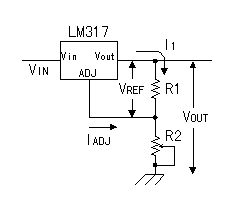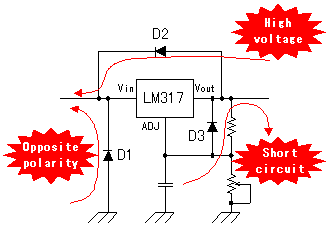
 The voltage control in the voltage variable type 3 terminal regulator The voltage control in the voltage variable type 3 terminal regulator
In case of the 3 terminal regulator that is using this time, the output voltage can be changed by changing the value of the resistor.
LM317 is for the positive power supply and LM337 is for the negative power supply. Either of the operation works similarly.
 The voltage control range The voltage control range
 The figure on the left is the basic circuit of the regulator. The nominal reference voltage between Vo and Adj is 1.25 V, being constant. The figure on the left is the basic circuit of the regulator. The nominal reference voltage between Vo and Adj is 1.25 V, being constant.
It is possible to do the adjustment of the output voltage by changing the value of R2.
The output voltage (Vout) can be calculated by the following formula.
Vout = 1.25 ( 1 + R2/R1) + IADJ(R2)
IADJ is the electric current which flows from the Adj pin and it is tens of µA. Because it is, you can omit it, too.
There is limitation to decide the resistance value for the voltage adjustment in LM3xx. It is the limitation that the voltage control doesn't work normally when the output current is not equal to or more than 10 mA. You do not need to consider this limitation when the load which the equal to or more than 10 mA electric current always flows through is connected. However, when there is a condition of the no-load like the power supply for the experiment and so on, you must consider this limitation. That you consider is the fact to make the value of R1 about 120 ohm. In this way, the output current flows by 10 mA even if it is minimum.
The value of R2 can be calculated by the following formula.(It ignores IADJ).
R2 = 120 ( Vout/1.25 - 1 )
In case of the 5 V output voltage, it is as follows.
| R2 | = 120 x ( 5/1.25 - 1 ) |
| = 120 x 3 |
| = 360 ohm |
I used the 500 ohm variable resistor with the circuit this time. Because it is, the adjustment range with the output voltage becomes 1.25V to 6.46V in the calculation.
 The condition with the input voltage The condition with the input voltage
In case of LM3xx, doing 3 V of minimum the differences between the input voltage and the output voltage are necessary. That is, the input voltage must be equal to or more than 3 V higher than the output voltage. In case of the 5 V output voltage, equal to or more than 8 V of the input voltage are necessary.
In case of LM317, the difference with voltage of the input and the output is a maximum of 40 V. Because the most low voltage of the output is 1.25 V, the upper limit with the input voltage becomes 41.25 V correctly. Generally, it makes the maximum input voltage 40 V. Because it is, the voltage adjustment range by LM317 becomes 1.25V - 37V.
In LM337, the polarity with the voltage is opposite but the adjustment range is same.

 The protection of the regulator The protection of the regulator
 I put some diodes outside the regulator. They are protecting the regulator. Even if it doesn't put these diodes, the regulator works. I considered the accident and put these diodes. I put some diodes outside the regulator. They are protecting the regulator. Even if it doesn't put these diodes, the regulator works. I considered the accident and put these diodes.
D1 is the protection when the voltage of the opposite polarity is applied to the input.
When having the rectification circuit of the AC power supply, the voltage which is opposite is not applied. If you are careful at the time of the construction, you do not need to put this diode. Because the equipment which was made this time is the way of connecting the ±12V power unit outside with the wire, then I put this diode. I used the diode for 1A. In case of being the power supply outside without 1A current limiting circuit's, the diode breaks.
The silicon diode becomes the short circuit condition when it breaks. The power unit may break when the outside power supply doesn't have the protection network.
D2 is the protection when the output voltage becomes higher than the input voltage.
When there are a coil and so on in the load circuit, there is possibility that the high voltage comes out when blocking off the electric current.
D3 is the protection when the output voltage falls from the voltage of the voltage adjustment pin.
When the output short-circuits, it becomes such a case.
 |